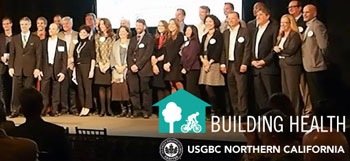The next version of LEED officially launches next month at Greenbuild, the US Green Building Council’s (USGBC) annual conference.
LEED v4 makes some important changes, specifically on addressing the toxicity of building materials, which could ripple across the vast construction industry.
Dovetailing with that, USGBC also announced the launch of the "Building Health Initiative." It aims to raise awareness of the building-health connection, shifting the market toward building products that promote human wellness.

It’s long been known that ingredients in common building materials – such as flame retardants and formaldehyde – cause serious health issues. LEED v4 and the Building Heath Initiative may well finally make a dent in the industry’s use of toxics.
Under LEED v4, building designers can get a point for simply disclosing ingredients in the products they use, toxic or not. The idea is to promote transparency about building materials, which in itself could spur manufacturers to make changes. Designers can get another point if the products they use do not contain hazardous chemicals.
To implement these goals for materials, members of the USGBC voted overwhelmingly to include Cradle to Cradle certification in the LEED V4.
Building Health Initiative
The idea is to elevate the health and wellness aspects of green building as vital components of sustainability. 27 partners have signed on to:
- Frame green as a health issue
- Elevate the topic within the industry
- Educate about the health impacts of the built environment
- Integrate diverse stakeholders – real estate, building, legal, and healthcare professionals and institutions
Among the initial partners building materials manufacturers such as InterfaceFLOR and Armstrong, architectural firms HOK and HDR, and Google, Adobe, CalPERS, Kaiser Permanente, and University of California, San Francisco.
"This is the first time major corporations and institutions from multiple sectors have come together to publicly commit to improving human health through green building," says Dan Geiger, executive director of the North California Chapter of USGBC, which is leading the initiative.
Adobe, Genentech, Google and salesforce.com will develop procurement practices that favor transparency in building materials and emerging standards such as Health Product Declarations, which standardizes descriptions of materials and associated health impacts.
Adobe will also study its LEED-certified workplaces to determine if they measurably contribute to more collaborative, creative, innovative and healthy employees.
Line in the Sand
As LEED moves in the direction of greater stringency and a focus on health, industry stakeholders invested in keeping the status quo are pushing Green Globes as a replacement for LEED.
They just had a big win, when this week the federal government announced it is putting Green Globes on par with LEED as a certification system for its buildings.
The chemical and plastic industries are among the 27 trade groups lobbying for Green Globes instead of LEED. Their interests are solidly pro-industry and many members have taken issue with LEED in the past for being too stringent – including the US Chamber of Commerce, American Chemistry Council, National Association of Manufacturers and Vinyl Institute.
"We salute the USGBC’s courageous leadership in making material health a priority in the face of immense challenge from industry," says architect Bill McDonough, who co-developed Cradle-to-Cradle certification. "The stand they have taken will help continue their meaningful input as an agent of market transformation."
Here’s the Building Health Initiative website:

Thanks for the article. Here’s some more details from a post of mine: “Forget green: Healthy buildings are the next big thing” http://smrt.io/16XqOHG